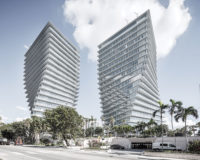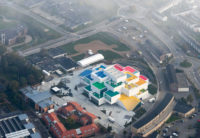Within New York’s recent architectural renaissance, Via 57 West—appearing like a giant silver sailboat along the Hudson River on Manhattan’s far West Side—is an anomaly. Sure, luxury residential towers by a slew of A-list architects are going up at a record pace in the city. And while most are nice enough, and indeed an improvement on the bland, white-brick piles of decades past, not many examples from the current crop are really pushing the envelope. Via 57, on the other hand, with its pyramidal shape and sweeping roof-cum-facade, is a radical departure from the apartment block typology.
So how did it get built? To hear Bjarke Ingels tell it, it happened by chance. But after several not-so-chance meetings beginning in 2007 with Douglas Durst, developer of the 709-unit, 831,000-square-foot Via 57, Ingels had his first major commission in the U.S. With it came the opportunity to open a New York office—now 200 strong—of his Copenhagen-based Bjarke Ingels Group (BIG), and to bring his BIG ideas, exemplified in projects like the sloping, bow-shaped, 475-unit 8 House in his native Denmark, to a still conservative New York real-estate market.
For the developer, that kind of dynamic architecture is perhaps just what was needed to draw potential tenants to a difficult location. Hemmed in by a Con Ed power station, a sanitation garage, and the noisy West Side Highway, the site is also a 15-minute walk to the closest subway station—an unappealing hike by Manhattan standards. “Residential was not our first thought for this lot,” says Jordan Barowitz, vice president and director of external affairs for the Durst Organization, which originally considered putting a data or health-care facility there.
How the building physically got built is surprisingly straightforward, given its complex geometry—which starts as a rectangle at the base and whose three walls (rather than the four of an actual pyramid) come to a point 467 feet above the ground. In order for that to happen, the largest wall, facing southwest, takes on a hyperbolic paraboloid shape. That unitized facade is composed of 1,200 curved stainless-steel cladding components, each unique and fabricated off-site, that were abrasive-blasted for a textured finish. Ranging in size from 25 to 30 feet wide, they are clipped onto tracks that run up and down the simple post-and-beam concrete structure.
Building that twisting surface may have been easy enough, but designing it from inception to execution was a challenge. “That element infused so much coordination among so many consultants, from cleaning and building-maintenance concerns to water management,” says BIG partner and project leader Beat Schenk. “But it is the heart of the building.”
Scooped out of its midsection is a generously proportioned and beautifully landscaped courtyard—what Ingels calls an “oasis” in the midst of less than idyllic neighbors. And it is just that. With sunset views of the Hudson, the courtyard offers communal grills for outdoor barbeques or purpose-built tables for a game of chess.
The list of amenities gets longer inside the building: a community room, pool, basketball court, gym, and a game room complete with skee ball, air hockey, and poker tables, to name a few. That comes at an additional $80-a-month fee on top of what are pricey rents—starting at $3,700 for a studio—even for New York. Of the 709 units, just over 200 had been spoken for by the start of last month after going on the market in May. According to Barowitz, “That’s an average absorption rate for rentals in Manhattan.” Some floors are still under construction, though tenants began moving in earlier this summer. The pace may pick up when retail tenants, including the American Kennel Club and Landmark Theatres—bringing up to eight movie screens to the building—move in next year.
A third of the units overlook the courtyard, each of them with a private terrace or balcony. Ingels, in fact, calls the building a “courtscraper”—combining features of a classic European courtyard building and a skyscraper. That manipulation of scale, however, has both advantages and drawbacks. The upper-level units—the highest occupiable floor is the 31st (above that, where the building reaches its summit, is mechanical space)—feel expansive and have stunning views. Deeper inside, however, translating that compact European building type to a long New York City block has resulted in endless corridors. Some studio units at the end of the hallway on the south side, where the building curves in, fall victim to the compressed floor plan there. The rest of the layouts, which BIG did not design, are fairly standard—it’s not spacious luxury for which tenants are paying a premium.
If you’re a kid with a lot of start-up or hedge fund money, who takes an Uber to work in the morning and enjoys a round of virtual golf when you get back at night, this may be the perfect place to call home. But even the highest-concept architecture can’t overcome deficiencies of location or aspects of the development that are out of the architect’s control. Still, it was a rare achievement that Via 57 got built, and Ingels has succeeded in creating an instant icon on the New York skyline.
Click and drag to experience the virtual reality film in 360 degrees.
Video © Squint/Opera
PeopleArchitect: Bjarke Ingels Group — Bjarke Ingels, Thomas Christoffersen, partners in charge; Beat Schenk, project leader Architect of Record: SLCE Architects — Luigi Russo, managing principal Engineers: Thornton Tomasetti (structural); Dagher Engineering (m/e/p); AKRF (environmental); Langan Engineering (civil); Philip Habib & Associates (transportation) Consultants Starr Whitehouse (landscape); Vidaris (building envelope, sustainability); Enclos (facade); Cerami & Associates (acoustics); Nice Kern (wayfinding); Van Deusen & Associates (vertical transportation); Brandston Partnership (lighting); CPP (wind engineering and air quality) General contractor: Hunter Roberts Construction Group Client: The Durst Organization Size: 831,000 square feet Cost: withheld Completion date: August 2016
|
ProductsMetal Facade Panels Contrarian Metal Resources Glass PPG Rolling Doors Cookson Wood Ceilings 9Wood Custom Woodwork PGS Millwork Surfaces Caesarstone, Wilsonart Plumbing Grohe, TOTO, Moen, Kohler, Elkay Exterior Lighting Selux, BEGA, Jesco, Inter-Lux Interior Ambient Lighting KiBiSi, Lumenpulse, Bartco, Bec Brittain, Selux, Flos, Zaneen, Delta Light, Lucifer Lighting Company, Louis Poulsen, Bega, ALW, Vode, Acolyte, iGuzzini Wall Coverings Wolf Gordon (corridors); Guardian (elevator cabs) Elevators Fujitec Bamboo Paneling Plyboo Felt Panels and Curtains Kvadrat Paint Benjamin Moore Tile Daltile (pool, bathrooms); Allstate (fitness area) Resilient Flooring Globus Cork Carpet Interface |
















Post a comment to this article
Report Abusive Comment